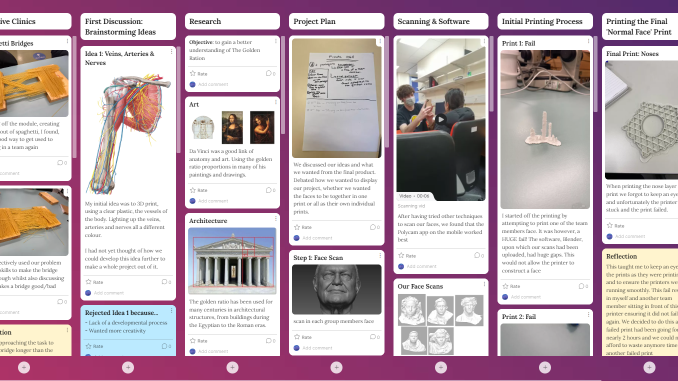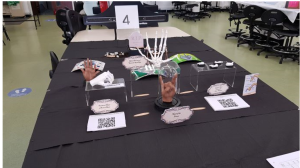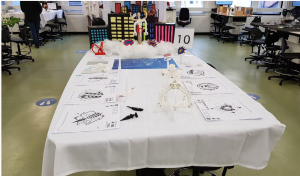
Module Leads and Organisers: Dr Mandeep Gill Sagoo, Dr Richard Wingate, Dr Kawal Rhode and Dr Leigh Wilson
Module: Level 5 Synthetic Anatomy, Department of Anatomy in the School of Bioscience and Biomedical Engineering and Imaging Sciences, FoLSM
Assessment activity: Students are assessed on their learning journey to produce a 3D printed design (but just not the design product!) through a group project, individual contribution to group work and reflective individual padlet.
Why did you introduce the assessment?
This is a 3D printing module co-organised by the Department of Anatomy in the School of Bioscience Education and the School of Biomedical Engineering & Imaging Sciences (both in the Faculty of Life Sciences and Medicine).
It runs over 10 weeks and counts for 15 credits. The aim of the module is to explore anatomical structure in a choice of possible contexts: development, evolution, structure and function. Students are assessed on the presentation of a series of ideas that both illustrate project development, but which also reflect the dynamic nature of anatomy.
To constructively align the assessment with this innovative module and in our attempt to make it an assessment for learning, we use individual reflective padlet and a group table display along with ‘Individual contribution to group work’ to assess students’ knowledge, reflective and team working skills. Assessment is geared to what students do and how they engage in the module but not on the completeness of the final “product”. A single, polished 3D print gives less information than an ordered collection of developmental stages of the project in a superbly explained context. This could include unsuccessful attempts. In other words, the emphasis is on the journey rather than the product.
We want students to feel confident to take risks with their project and to be ambitious. Reflecting on the choices they make, their relative success and then thinking forward to how to improve these processes is valuable learning in becoming more effective problem solvers. Because this module is run by two departments, we have Bioscience and Bioengineering students, who are coming from different disciplinary backgrounds. We want them to work together and collaborate as this is one of the aims of the module.
How did you set it up?
Synthetic Anatomy is a module in two parts. The first involves learning about data sets and 3D printing, the second about applying this knowledge and these skills to a project that involves printing a series of speculative anatomies. These can range from imagined adaptations of the future human brain or skeleton to idealized joints for baseball pitchers to the developmental series of an extinct vertebrate. The goal is to explore and take risks. The philosophy of the course involves accepting and learning from failed prints, frustrating team conversations, and disagreement about the aims of a project. In other words, the reality of group design work! So these troubles are all equally valuable as “success” if a lesson are taken on board and applied.
Students are assessed on an individual online pin-board “padlet”. The group project is assessed using a “table display” of 3D prints and attempts at 3D prints, and because engagement throughout the project is crucial, we used individual contribution to group work methodology this year. Here is an example of a group table display.

These modes of assessment require a different approach to thinking about study. Reflection on the choices made in working towards the goal, the challenges faced and how they navigated through them and their effectiveness is the basis of an excellent grade rather than the completeness of the final project.
Students are randomly allocated to groups to use 3D technology to address an anatomical ‘problem’ or idea. We ensure that students from each of the two discipline areas will be in each group. The group gathers all their work together to present at the end of the module. The second part of the assessment is an individual reflection on their process, including everything that showcases their learning journey.
Before the 2020 pandemic and this year, we have an unmanned table display for students to showcase their group work at the end of the module, where marks would be given (see picture above). We are interested in their stages of development rather than just the final product, so the table had to speak for itself! We minimised the use of text that they could use, and they had to use lots of props instead. During the pandemic we used Padlet for this. Padlet has several technical and education perks including a use- friendly multi-user interface, is cumulative, allows live feedback, and provides a snapshot of the journey for our students.
The first four iteration of the individual reflective eportfolio used Mahara where students reflected on everything they have done during the 3D printing project and how they have conceptualised their learning. We have now moved to Padlet for this from January 2022. We felt that an eportfolio did not allow students to demonstrate a snapshot and mindmap of their learning to do justice to each element so we replaced it with padlet.
How did you design the assessment criteria and weighting?
Their summative assessment involved group project work and is assessed on the basis of a group presentation of the project through table display (40% of final mark) including individual contribution to group work (10% of final mark), and their individual’s reflection was assessed through Padlet (50% of final mark).
40% group project and table display. The grade is shared between the group. But we have added the element of ‘individual contribution to group work’ to ensure fairness of the marks allocated to each student in a group, and an opportunity for students to learn from their peers through constructive peer feedback. Students were asked to fill a questionnaire on Keats and rate and comment on each of their peers (including themselves) on the following elements:
- attendance and reliability
- communication
- meeting deadlines
- teamwork
and these scores were analysed using UCL’s peer assessment Software, IPAC and then 10% of these scores were added to their final mark.
The rubric is based on the way the tutor views the work. So, we start with whether the work is comprehensible, and how it has been presented, as well as certain elements of their process are present, such as: the trial and error of the 3d models, the explanation of their chosen problem and why decisions were made.
The Criteria for marking:
- first impression
- explanation of the problem and its context
- display trial and error
- effective use of technical reflection
- effective use of scales and materials
- quality of 3d prints
- pride in the finished product
How do you give feedback?
In week 6, we have a Pecha Kucha session (2-3 slides for 3 minutes) for students to showcase their project ideas in and what they have done so far and receive feedback from peers and us as tutors. This is their first formal collective feedback session.
On the day of table display , the students give each other peer feedback in a face-to-face ‘Crit’ session, based on an assessment which is common to Art and Architecture degrees. The Crit is challenging and in the moment, accounts for thought processes in addition to product quality and helps drive reflection and reflexivity. We had 2 artists from Royal College of Arts and Norwich University of Arts to lead the ‘crit’ (see below for peer feedback). Students can then take that feedback and use it in their padlet to show how they changed their work.
We have around 10 tutors who help facilitate students’ project work. Some groups require a little more guidance than the others and the tutors are not anatomy/3D printing experts.
We believe that in the crit sessions, our students were more constructive and critical because the timing of this session takes place AFTER the summative presentation, and students did not worry about whether their feedback would influence their peer’s grades so they could focus on feedback only!
Also they get written comprehensive feedback for their table display and padlets.
What benefits did you see?
- Students engaged with the learning outcomes specifically in reflecting on what they had achieved. They defined success through pride in their work, showing that the assessment was meaningful. We sometimes ask students to come along and showcase things in the Science gallery, and the public nature of this seems inherently motivating to students.
- Group work and team-work skills are built in the way they navigate issues and through the peer feedback.
- The quality of students’ work was great, creative and well thought-through. The example below is on a bionic eye using technology and ethics as well as marketing! They were really considering interdisciplinarity. Most students received a high 2:1. Some use multimedia, role play etc.
- Some students wanted to be put in touch with the experts in this area so they could learn more! It showed that the learning doesn’t stop once the assessment is over! Some students came to the labs over the weekend, so they were clearly motivated
- Lack of hierarchy between teachers and students. We all work together in the labs and learn as much from them as they do from us.
- We believe it may be stress or anxiety for students than a traditional end of course exam.
What challenges did you encounter and how did you address them?
GROUP WORK:
- At the beginning of the module, students from bioscience and bioengineering disciplinary backgrounds are less comfortable working together. On day one we have a session where they have to build a spaghetti bridge longer than the length of the original spaghetti. This sort of ‘serious play’ breaks down barriers of disciplines where student have to work together.
- Sometimes there is the issue of one or two students not contributing as well in the team as others. This year we will be trialling the use of the IPAC tool from UCL which allows students to give peer feedback on the group contribution of others (see below)
REFINEMENTS TO THE PLATFORM FOR THE INDIVIDUAL REFLECTION:
- Last year we provided a scaffolding of titles to the padlet pages to suggest a structure but this was by no means a rigid one and we encouraged students’ to edit it as needed but we found that very few were taking ownership and making changes to this to show their own development and creativity. Therefore, we changed this to give them far fewer prompts. Students then seemed to be more creative and make choices about the cohesiveness of their presentations of their artefacts.
- This year post pandemic, we have trialled Padlet for the efolio rather than With the increasing numbers of students, efolio tools can be very time consuming to mark, and the Padlet so far has been more comprehensive. Padlet allows a mind map and visual overview of their journey in a much better way than Mahara. It also helps the students to see what they need to reflect on based on the way they have organised their group presentation Padlet.
MARKING:
- Our student numbers have increased over the years. For the table display, we 3 module leads, module organiser and the artists marked the work. Tutors were invited but they didn’t marked the table displays. We also 2nd marked a range of them. . However, every piece is new and exciting and there is a cost-benefit analysis in the time it might take to mark vs the interesting work we see, more so than in an MCQ. We are also considering capping the number of students on this model to ensure the best experience for them.
- We had some restrictions for the rubric as it had to benchmark to the department. We were more focused on the development than the product itself, and how students solved or navigated problems. Because of the interdisciplinary nature of the course and including elements of art assessment, we had to marry two types of disciplinary conventions for the criteria. We were aware that external examiners may consider elements of creativity etc to be less objective. We improved our marking rubrics over the years to do justice to these innovative assessments along with benchmarking the criteria to the department and refine our criteria to be accepted through external scrutiny (see above).
What are your next steps?
- Trialling Individual Peer Assessment of Group Work (IPAC) software from UCL for a 10% grade of peer feedback for group contribution. This will be a plug in to KEATS and CTEL are helping us with this. https://www.ucl.ac.uk/centre-for-engineering-education/news/2021/jun/individual-peer-assessment-group-work-ipac-new-software-seminar-and-workshops
- We will continue to monitor the use of padlet for the reflective efolio.
What advice would you give to colleagues who are thinking of trying this type of assessment?
- Interdisciplinarity has many benefits but as one size does not fit all, it might not work in modules where students need to know core module, and that is fine. But the idea of cross disciplinary collaboration is so important for students’ future careers. Subjects cannot stand alone and evolve, so we need expertise from different backgrounds.
- All our artists have been fantastic in guiding the crit and artists’ workshops, but I would say it does depend sometimes on the artist as to how successful the session would be. I would say that bringing in external partners is great, but the right people is crucial!
- Involve students in the assessment by asking them what they want to achieve at the start, not just asking them in post-module evaluation! Although you would not be able to change learning objectives or outcomes in the MAF, the difference is often minimal between what they want to achieve and what you want them to. But it allows you to make some tweaks as to where you invest time with them and what they want to focus on. This has been an iterative process (like an action research) for us as we have reflected on teaching and assessment strategies over the past 3 years and tweaked them to fit well within the module.
- Padlet has some accessibility issues but the padlet company are working on this https://padlet.com/about/accessibility Because we don’t specify a format for the students and they choose how to present, they have more control over the fonts etc.


Leave a Reply